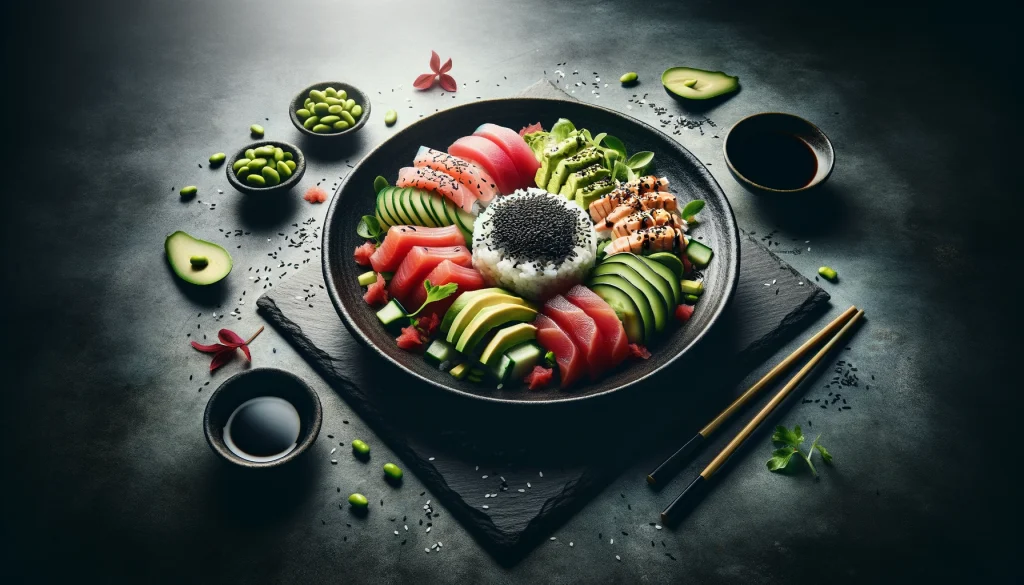As an Amazon Associate I earn from qualifying purchases.
In the world of culinary fusion, the Sushi Salad stands out as a vibrant and innovative reinterpretation of traditional sushi. This delightful dish retains the essence of what makes sushi so beloved – the harmonious blend of flavors and textures – but presents it in a refreshing new form. Imagine all the elements of your favorite sushi roll, deconstructed and served as a tantalizing salad. This recipe offers a unique experience that marries the convenience of a bowl meal with the intricate flavors of sushi. Whether you are a sushi aficionado or a salad lover, this Sushi Salad recipe is an exciting journey into a world where the boundaries of traditional cuisine are reimagined. Perfect for a light lunch, a healthy dinner, or even as a standout dish at gatherings, Sushi Salad brings the exquisite tastes of Japan to your table in a simple, approachable format. Let’s dive into how you can create this culinary delight, layer by layer, in your kitchen.
———-
Most Popular
———-
Ingredients
For a delectable Sushi Salad, gather sushi rice, fresh vegetables like cucumber, avocado, and carrot, along with seafood such as crab or shrimp. Elevate the flavors with rice vinegar, soy sauce, and nori strips for an authentic sushi experience.
Where to Buy the Best Ingredients
Lundberg Organic California Sushi Rice, 32 Oz (Pack of 2) : Price on Amazon
Marukan Rice Vinegar, 1 Gallon : Price on Amazon
Iberia Turbinado Sugar 2 lb. (Pack of 3) : Price on Amazon
Happy Belly Sea Salt, 1 pound : Price on Amazon
Kikkoman Soy Sauce, 5 Fl Oz (Pack of 2) : Price on Amazon
La Tourangelle Toasted Sesame Oil, 8.45 Fl Oz : Price on Amazon
…
Recipe Information
Servings: 4 servings
Prep Time: Approximately 20 minutes
Cooking Time: No cooking required
Calories: The calorie count can vary based on the specific ingredients and portion sizes used in your Sushi Salad. On average, a serving of Sushi Salad may contain around 300-400 calories. However, it’s essential to calculate the exact calorie count based on your specific recipe and ingredients for accuracy.
…
Sushi Salad Recipe

Sushi Salad is a deconstructed version of traditional sushi, combining all the familiar flavors in a bowl. This recipe includes sushi rice seasoned with a mixture of rice vinegar, sugar, and salt. The salad is composed of fresh vegetables like cucumber, avocado, shredded carrots, and bell pepper, along with cooked edamame and optional sashimi-grade fish such as salmon or tuna. Strips of nori (seaweed sheets) add a sushi-like touch. The salad is dressed in a flavorful mixture of soy sauce, sesame oil, rice vinegar, wasabi paste, and grated ginger, enhancing the sushi experience. Topped with sesame seeds and chopped green onions, this salad offers a blend of sushi flavors in a convenient and customizable bowl format. It’s a fresh and satisfying dish that’s perfect for sushi lovers looking for a quick and easy meal.
Sushi Salad is a creative and deconstructed take on traditional sushi, offering all the flavors you love in a convenient, bowl-style format. Here’s a simple recipe to create a delicious Sushi Salad:
Ingredients
Rice:
- 2 cups sushi rice
- 2 1/2 cups water
- 1/4 cup rice vinegar
- 2 tablespoons sugar
- 1/2 teaspoon salt
Salad Components:
- 1 cucumber, thinly sliced
- 1 avocado, sliced
- 1/2 cup shredded carrots
- 1 small bell pepper, thinly sliced
- 1/2 cup edamame, shelled and cooked
- Seaweed sheets (nori), cut into small strips
- Fresh sashimi-grade fish like salmon or tuna, cut into bite-size pieces (optional)
Dressing:
- 3 tablespoons soy sauce
- 2 tablespoons sesame oil
- 1 tablespoon rice vinegar
- 1 teaspoon wasabi paste (adjust to taste)
- 1 teaspoon ginger, grated
- Toppings:
- Sesame seeds
- Green onions, chopped
Instructions
Cook Rice:
- Rinse the sushi rice until the water runs clear.
- Cook the rice with water in a rice cooker or on the stovetop.
- Once cooked, mix rice vinegar, sugar, and salt, and gently fold into the rice. Let it cool to room temperature.
Prepare Vegetables and Fish:
- Cut cucumber, avocado, bell pepper, and fish. Shred carrots and chop green onions.
Make the Dressing:
- Whisk together soy sauce, sesame oil, rice vinegar, wasabi paste, and grated ginger in a small bowl.
Assemble the Salad:
- In a large bowl, place a bed of sushi rice.
- Arrange the cucumber, avocado, carrots, bell pepper, edamame, and fish (if using) on top of the rice.
- Sprinkle with nori strips, sesame seeds, and green onions.
Add Dressing:
- Drizzle the dressing over the salad before serving.
Serve:
- Mix the salad to combine all the ingredients and enjoy!
Enjoy this fresh, flavorful, and easy-to-make Sushi Salad that brings the essence of sushi to your table in a new and exciting way!
TIPS
Making a delicious Sushi Salad can be a delightful culinary experience. Here are some tips to enhance your dish:
- Quality of Rice: Use sushi rice for the best results, as it has the right stickiness and texture. Rinse the rice thoroughly until the water runs clear to remove excess starch.
- Seasoning the Rice: The flavor of the salad largely depends on the rice. Ensure you season the cooked rice with a blend of rice vinegar, sugar, and salt while it’s still warm for better absorption of flavors.
- Vegetable Preparation: Slice the vegetables thinly for a texture that complements the rice. This also makes the salad easier to eat.
- Fish Selection: If using fish, choose fresh sashimi-grade fish for safety and quality. If you’re not comfortable with raw fish, you can substitute with cooked shrimp, crab, or even smoked salmon.
- Balanced Dressing: The dressing should have a balance of salty, sweet, and tangy flavors. Adjust the wasabi and ginger according to your taste for the right amount of heat and zing.
- Letting the Rice Cool: Allow the rice to cool to room temperature before assembling the salad. Hot rice will wilt the vegetables and change the texture of the salad.
- Nori Sheets: Add nori (seaweed) sheets for an authentic sushi flavor. Cut them into thin strips for easy mixing and eating.
- Customization: Feel free to customize the salad with your favorite sushi ingredients. Options like mango, pickled ginger, or even tofu can add unique flavors.
- Presentation: For an appealing presentation, arrange the ingredients in sections on top of the rice before serving. This makes the dish colorful and appetizing.
- Serving: Serve the salad soon after assembling to enjoy the freshness of the ingredients. If you need to store it, keep the dressing separate until ready to serve.
By following these tips, you can create a Sushi Salad that’s not only flavorful and satisfying but also visually appealing and tailored to your taste preferences.
Why This Recipe Is Just So Good…

The Sushi Salad recipe is exceptional for several reasons, making it a delightful and popular dish:
- Flavorful Fusion: It combines the beloved flavors of traditional sushi with the convenience and ease of a salad. The blend of sushi rice, fresh vegetables, optional seafood, and a savory dressing creates a symphony of flavors that sushi enthusiasts adore.
- Textural Variety: The dish offers a wonderful interplay of textures – the stickiness of the rice, the crispness of the fresh vegetables, the creaminess of the avocado, and possibly the tenderness of the fish. This variety adds an interesting and enjoyable dimension to each bite.
- Customizable to Taste: The recipe is highly adaptable to personal preferences. You can choose your favorite sushi ingredients, adjust the level of spiciness in the dressing, and even make it vegetarian or vegan if desired.
- Healthful and Nutritious: Sushi Salad is packed with a variety of fresh vegetables, providing essential nutrients and fiber. If you include fish, it adds healthy proteins and omega-3 fatty acids.
- Convenient and Easy to Prepare: Unlike traditional sushi, this salad doesn’t require the skill of rolling sushi, making it accessible and easy to put together, perfect for a quick meal or a special occasion.
- Visually Appealing: The array of colors from the different ingredients makes this salad a feast for the eyes. The vibrant greens, reds, and oranges of the vegetables, along with the white rice and optional fish, create an appealing presentation.
- Versatile Serving Options: It can be served as a main dish, a side, or even as an appetizer in smaller portions. It’s also great for picnics, potlucks, or as a refreshing summer meal.
- Satisfying Yet Light: While being filling and satisfying, the salad remains light and refreshing, making it a perfect choice for those looking for a fulfilling meal without feeling overly heavy.
In summary, Sushi Salad is not just a dish; it’s a delightful experience that brings the essence of sushi into an easy, versatile, and healthful form.
Storage Instructions
Storing Sushi Salad requires some care to maintain its freshness and flavors. Here are the storage instructions:
Immediate Consumption is Best:
- Sushi Salad is best enjoyed fresh. The textures and flavors are at their peak shortly after preparation.
Short-Term Refrigeration:
- If you need to store the salad, it’s recommended to keep the components separate. Store the rice, vegetables, and any seafood or dressing in separate airtight containers in the refrigerator.
- The salad can be refrigerated for up to 24 hours, though the quality is best within the first few hours of preparation.
Avoid Storing with Dressing:
- If the salad has already been mixed with the dressing, consume it within a few hours. The dressing can make the rice soggy and wilt the vegetables if left for too long.
Storing Cooked Sushi Rice:
- The sushi rice can be stored in the refrigerator for up to 48 hours. When ready to use, gently reheat it to bring back some of its stickiness and warmth.
Handling Seafood:
- If your salad includes raw fish, consume it as soon as possible. Raw fish shouldn’t be stored for extended periods due to the risk of spoilage and foodborne illness.
Reassembling the Salad:
- For the best experience, reassemble the salad just before eating. This will help maintain the texture and freshness of each ingredient.
Freezing is Not Recommended:
- Freezing Sushi Salad, especially if it contains fresh vegetables and raw fish, is not recommended as it will significantly degrade the texture and flavor of the ingredients.
By following these storage instructions, you can ensure that your Sushi Salad remains as fresh and delicious as possible if not consumed immediately.
Frequently Asked Questions (FAQ’s)

Here are some expert-level questions and answers on Sushi Salad:
Q: What is Sushi Salad?
A: Sushi Salad is a dish that deconstructs traditional sushi into a salad form. It typically includes sushi rice, various fresh vegetables like cucumber and avocado, optional seafood like sashimi-grade fish, and is dressed with a flavorful soy-sesame dressing. It’s a creative way to enjoy sushi flavors in a more casual, easy-to-prepare manner.
Q: Can I make Sushi Salad without raw fish?
A: Absolutely! Sushi Salad can be made without raw fish. You can either omit the fish altogether or substitute it with cooked seafood like shrimp or crab, or even with tofu for a vegetarian option.
Q: How do I cook sushi rice for the salad?
A: Cook sushi rice by rinsing it until the water runs clear, cooking it with an appropriate amount of water, and then seasoning it with a mixture of rice vinegar, sugar, and salt. The rice should be cooled to room temperature before assembling the salad.
Q: What dressing goes well with Sushi Salad?
A: A simple dressing made with soy sauce, sesame oil, rice vinegar, and a bit of wasabi or ginger pairs well with Sushi Salad, providing a balance of savory, sweet, and tangy flavors.
Q: Can Sushi Salad be stored for later use?
A: Sushi Salad is best enjoyed fresh. If you need to store it, keep the rice, vegetables, and dressing separate and assemble them just before serving. It can be refrigerated for up to a day.
Q: Is it possible to make Sushi Salad in advance?
A: You can prepare the components like rice, chopped vegetables, and dressing in advance, but it’s best to assemble the salad just before serving to maintain the freshness and texture of the ingredients.
Q: What are some good vegetable options for Sushi Salad?
A: Common vegetables in Sushi Salad include cucumber, avocado, shredded carrots, bell pepper, and edamame. You can also add greens like spinach or seaweed for extra flavor and nutrition.
Q: How can I add more protein to my Sushi Salad?
A: To add more protein, consider including ingredients like cooked chicken, tofu, tempeh, or additional seafood such as crab meat or cooked shrimp.
Q: What is the key to achieving the perfect sushi rice texture for a sushi salad?
A: The key to perfect sushi rice is the balance of stickiness and individual grain integrity. This is achieved by rinsing the rice until the water runs clear to remove excess starch, cooking it with the correct water ratio, and seasoning it while hot with a mixture of rice vinegar, sugar, and salt. The rice should be sticky enough to clump together slightly but not so much that it becomes mushy.
Q: How can the sushi salad be adapted for a low-carb or keto diet?
A: For a low-carb or keto adaptation, substitute sushi rice with riced cauliflower. Lightly steam the riced cauliflower and then cool it before seasoning with a keto-friendly vinegar, salt, and sugar substitute. This alternative mimics the texture and flavor of sushi rice while being low in carbohydrates.
Q: What are some ideal protein options for sushi salad besides traditional sashimi-grade fish?
A: Beyond sashimi-grade fish, you can include cooked shrimp, crab meat, smoked salmon, grilled chicken, or tofu for protein. These options cater to different dietary preferences and can add variety to the salad. Ensure that the chosen protein complements the overall flavor profile of the salad.
Q: How important is the role of dressing in sushi salad, and what are some variations?
A: The dressing is crucial as it brings together all the components of the salad with a burst of flavor. Traditional sushi salad dressing includes soy sauce, sesame oil, rice vinegar, and wasabi. Variations can include a citrusy ponzu sauce, a creamy sriracha mayo, or a ginger-soy vinaigrette for different flavor profiles.
Q: What are some effective ways to enhance the umami flavor in a sushi salad?
A: To enhance the umami flavor, consider adding ingredients like seaweed strips, a sprinkle of furikake, a dash of soy sauce, or even a few drops of fish sauce to the dressing. These elements contribute depth and a savory taste characteristic of umami.
Q: Is there a way to prepare sushi salad for a large group without compromising on quality?
A: When preparing sushi salad for a large group, it’s best to prep the ingredients separately and assemble individual servings just before eating. This approach maintains the freshness and texture of each component. For a buffet-style serving, keep ingredients in separate containers and allow guests to assemble their own salads.
By addressing these expert aspects, you can elevate your sushi salad experience, whether adapting it to dietary needs, experimenting with flavors, or serving it at gatherings.
Conclusion
As we conclude our culinary exploration of Sushi Salad, it’s clear that this dish is a testament to the versatility and adaptability of traditional flavors. By deconstructing the classic sushi roll into a salad, we open up a world of possibilities – a dish that is not only easier to prepare but also customizable to suit various tastes and dietary preferences. Sushi Salad is a celebration of freshness, combining the delicate flavors of sushi rice, the crispness of fresh vegetables, and the savory notes of seafood, all tied together with a zesty dressing.
This dish is more than just a meal; it’s a creative expression of contemporary cooking, where the essence of traditional sushi is transformed into something new and exciting. It’s perfect for those seeking the flavors of sushi with the ease of a salad, making it ideal for quick lunches, healthy dinners, or as a unique offering at social gatherings.
So, whether you’re a seasoned sushi lover or new to Japanese cuisine, Sushi Salad offers a delightful and approachable way to enjoy these flavors. It’s a dish that invites experimentation and personalization, encouraging cooks to explore and play with different ingredients. In every bite, Sushi Salad brings a refreshing and satisfying experience, making it a standout addition to any meal.






